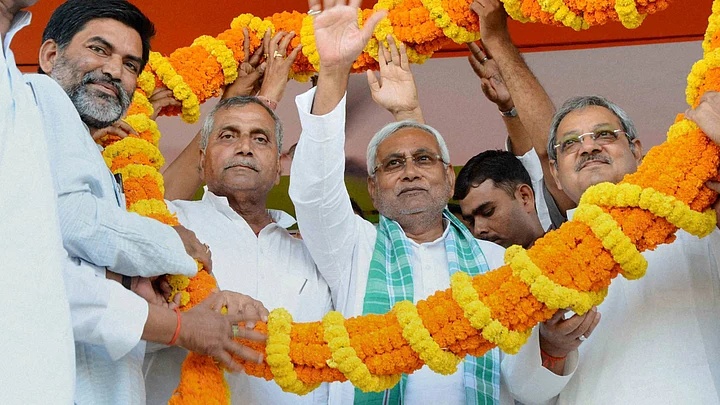As Nitish Kumar takes over charge as Bihar’s Chief Minister for the third time, here is a profile of the leader who began his political journey way back in 1977.
Journey from Humble Beginnings to Corridors of Power
Name: Nitish Kumar
Age: 64
Date of birth: March 1, 1951
Place of birth: Bakhtiyarpur, 35 kms from Patna
Education qualification: B Tech (Electrical) from Bihar College of Engineering (now called NIT, Patna)
Father: Late Ram Lakhan Babu, alias Vaidyaji, a veteran freedom fighter
Wife: Late Manju Sinha, school teacher
Son: Nishant, an engineering graduate from BIT, Mesra
Favourite food: Butter Masala Dosa
Nitish Kumar has a history of swimming against the tide. In 1977, when all the Janata Party stalwarts including Ram Vilas Paswan and Lalu Prasad won the Lok Sabha polls, Nitish could not win even an assembly election from Harnaut, the Kurmi-dominated constituency in his hometown Nalanda.
However, in the 1985 assembly polls, post-Indira Gandhi’s assassination, when most of the Janata leaders were blown over by a sympathy wave (for the former PM), Nitish won the election from Harnaut, from where he earlier failed twice (in 1977 and then again in 1980) before making his debut as an MLA. Since then, 1951-born Nitish has not looked back.
Brush with Politics
His first brush with politics was in the mid-70s when he was still pursuing his B.Tech (electrical engineering) from Bihar College of Engineering (now called NIT, Patna). Joining the students’ movement at the behest of his mentor and veteran socialist, Jaya Prakash Narayan, Nitish was imprisoned during Emergency.
Once the emergency was lifted, he, much like his young colleagues from the Janata Party, decided to join the hustle-bustle of Indian politics. After two unsuccessful attempts to become a lawmaker, Nitish eventually entered the assembly premises in 1985.
Soft-spoken, sharp and articulate, he soon earned plaudits for his speeches delivered in a measured tone. In 1987, he was appointed president of the Yuva Lok Dal followed by his elevation as secretary-general of Janata Dal in 1989.
The same year, Nitish was asked to contest the November 1989 Lok Sabha polls from Barh. The debutant parliamentarian defeated a towering Congress leader Ram Lakhan Singh Yadav, who was also known as Sher-e-Bihar.
Parting Ways with Bade Bhai
VP Singh noticed this and appointed him as Union Minister of State for Agriculture in his short-lived National Front Government. (Although Paswan and Sharad Yadav were given cabinet berths, while Lalu was kept in reserve for the top post in Bihar as assembly polls were due in March 1990).
In those good old days, Nitish backed Lalu to the hilt when the latter faced the initial challenge from within the Janata Dal (by Ram Sundar Das, backed by Ajit Singh and Raghunath Jha, backed by Chandrashekhar) before his coronation.
In the post-Mandal era, their friendship continued till 1994 before Nitish, as some analysts say, developed his unwavering aspirations for Bihar. After parting ways with his bosom friend whom he treated as Bade bhai (elder brother), Nitish formed the Samata Party with George Fernandes, another fiery socialist, as its head.
Reaching Out to the BJP
The following year, Nitish gave the electorate of Bihar, then an undivided State, a viable alternative to the JD, BJP and the Congress. But his outfit Samata Party – basically a conglomeration of his fellow castemen Kurmis – was completely routed. In the undivided Bihar, which then had 324 assembly seats, Nitish’s party could win barely seven. Lalu, however, won 167 seats in the 1995 polls thereby becoming the undisputed OBC leader and also the Bihar CM for the second consecutive term.
But failure was never a deterrent for Nitish either in the 70s or the 90s. He reworked his strategy after realising that only Kurmis, which were numerically weaker compared to the other OBC - Yadavs, could not help him dislodge his friend-turned-foe Lalu.
By the end of 1995, he, along with George, started building bridges with the BJP. In 1996, Samata Party became an ally of the BJP at a time when no party, other than Shiv Sena and Akali Dal, were willing to touch the saffron camp with a bargepole.
Social Engineering Strategy
Two years later, when Atal Bihari Vajpayee became Prime Minister, Nitish was sworn in as a Cabinet Minister. He served under Vajpayee from 1998 to 2004 in various capacities as the Railway, Surface Transport and Agriculture Minister.
In between, he had a brief stint as Bihar CM for seven days in March 2000 where he quit after he could not muster support to prove his majority in the assembly.
But then, like previous occasions, when every failure made his resolution all the more firm, Nitish reworked his social engineering strategy and made a rainbow coalition of OBCs, EBCs, Mahadalits and minorities. Five years later, this helped him sweep Bihar in November 2005 elections, thereby uprooting 15 years of uninterrupted Lalu-Rabri rule.
Today, as he gears up to don the Bihar mantle for the third time (technically fifth time if you add March 2000 and again February 2015 swearing-in), life has come a full circle for Nitish as he is back in the saddle with the help of his friend who, for the last two decades, remained his sworn enemy. But to take the common foe Narendra Modi head-on, Nitish thought it’s prudent to make enemy’s enemy a friend.
The rest, as they say, is history.
(The writer is a Bihar-based journalist)
